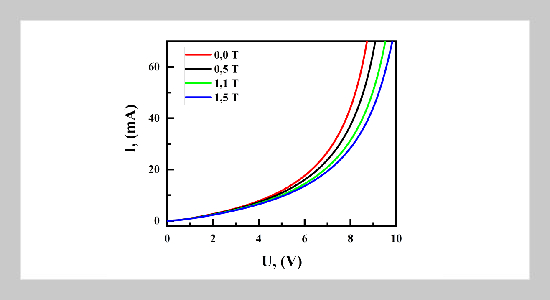- [1] G. Gulyamov, U. I. Erkaboev, N. Y. Sharibaev, and A. G. Gulyamov, (2019) “EMF Induced in a p–n Junction under a Strong Microwave Field and Light" Semiconductors 53(3): 375–378. DOI: 10.1134/S1063782619030060.
- [2] G. Gulyamov, A. G. Gulyamov, and U. I. Erkaboev, (2018) “Thermal Stimulation of Photocurrent in p–n Junctions" Applied Solar Energy 54(5): 338–340. DOI: 10.3103/S0003701X18050079.
- [3] X. Feng, X. Zhao, L. Yang, M. Li, F. Qie, J. Guo, Y. Zhang, T. Li, W. Yuan, and Y. Yan, (2018) “All carbon materials pn diode" Nature Communications 9(1):3750. DOI: 10.1038/s41467-018-06150-z.
- [4] G. Gulyamov and A. G. Gulyamov, (2015) “On the tensosensitivity of a p-n junction under illumination"Semiconductors 49(6): 819–822. DOI: 10.1134/S1063782615060111.
- [5] S. H. Shamirzaev, G. Gulyamov, M. G. Dadamirzaev, and A. G. Gulyamov, (2009) “Eddy currents in the p–n junction in a microwave field" Semiconductors 43(9): 1170–1173. DOI: 10.1134/S1063782609090127.
- [6] T. Tuan, D.-H. Kuo, C.-C. Li, and G.-Z. Li, (2015) “Effect of Temperature Dependence on Electrical Characterization of p-n GaN Diode Fabricated by RF Magnetron Sputtering" Materials Sciences and Applications 6: 809–817. DOI: 10.4236/msa.2015.69083.
- [7] G. J. Monkman, D. Sindersberger, and N. Prem, (2022) “Magnetically enhanced photoconductive high voltage control" ISSS Journal of Micro and Smart Systems 11(1): 317–328. DOI: 10.1007/s41683-021-00088-z.
- [8] J. Xu, M. K. Ma, M. Sultanov, Z.-L. Xiao, Y.-L.Wang, D. Jin, Y.-Y. Lyu, W. Zhang, L. N. Pfeiffer, K. W. West, K.W. Baldwin, M. Shayegan, andW.-K. Kwok, (2019) “Negative longitudinal magnetoresistance in gallium arsenide quantum wells" Nature Communications 10(1): 287. DOI: 10.1038/s41467-018-08199-2.
- [9] Z. Luo and X. Zhang, (2017) “Magnetic logic based on diode-assisted magnetoresistance" AIP Advances 7(5): 055920. DOI: 10.1063/1.4975046.
- [10] Z. Wang, L. Yang, X. Zhao, Z. Zhang, and X. P. A. Gao, (2015) “Linear magnetoresistance versus weak antilocalization effects in Bi2Te3" Nano Research 8(9): 2963–2969. DOI: 10.1007/s12274-015-0801-3.
- [11] L. Chang, X. Wang, Y. Zhang, H. Li, and Y. Yan, (2018) “Magnetoresistance of a self-assembled polyaniline single microfiber" Journal of Materials Science 53(20): 14850–14857. DOI: 10.1007/s10853-018-2640-6.
- [12] K. Shrestha, V. Marinova, D. Graf, B. Lorenz, and C.W. Chu, (2017) “Large magnetoresistance and Fermi surface study of Sb2Se2Te single crystal" Journal of Applied Physics 122(12): 125901. DOI: 10.1063/1.4998575.
- [13] D. Ding, X. Dai, C.Wang, and D. Diao, (2020) “Temperature dependent crossover between positive and negative magnetoresistance in graphene nanocrystallines embedded carbon film" Carbon 163: 19–25. DOI: https ://doi.org/10.1016/j.carbon.2020.03.022.
- [14] K. Zhang, H.-h. Li, P. Grünberg, Q. Li, S.-t. Ye, Y.-f. Tian, S.-s. Yan, Z.-j. Lin, S.-s. Kang, Y.-x. Chen, G.-l. Liu, and L.-m. Mei, (2015) “Large rectification magnetoresistance in nonmagnetic Al/Ge/Al heterojunctions" Scientific Reports 5(1): 14249. DOI: 10.1038/srep14249.
- [15] Y. Zhang, J. Fan, Q. Huang, J. Zhu, Y. Zhao, M. Li, Y. Wu, and R. Huang, (2018) “Voltage-Controlled Magnetoresistance in Silicon Nanowire Transistors" Scientific Reports 8(1): 15194. DOI: 10.1038/s41598-018-33673-8.
- [16] M. P. Delmo, E. Shikoh, T. Shinjo, and M. Shiraishi, (2013) “Bipolar-driven large linear magnetoresistance in silicon at low magnetic fields" Phys. Rev. B 87: 245301. DOI: 10.1103/PhysRevB.87.245301.
- [17] J. Panda, P. Banerjee, and T. K. Nath, (2014) “Electrical spin extraction and giant positive junction magnetoresistance in a Fe3O4/MgO/n-Si magnetic diode like heterostructure" Journal of Physics D: Applied Physics 47(41): 415103. DOI: 10.1088/0022- 3727/47/41/415103.
- [18] L. H. Wu, X. Zhang, J. Vanacken, N. Schildermans, C. H. Wan, and V. V. Moshchalkov, (2011) “Roomtemperature nonsaturating magnetoresistance of intrinsic bulk silicon in high pulsed magnetic fields" Applied Physics Letters 98(11): 112113. DOI: 10.1063/1.3569139.
- [19] L. Botsch, I. Lorite, Y. Kumar, P. Esquinazi, T. Michalsky, J. Zajadacz, and K. Zimmer. Spin-filter effect at the interface of magnetic/non-magnetic homojunctions in Li doped ZnO nanostructures. 2017. arXiv: 1705.08124 [cond-mat.mes-hall].
- [20] T. Wang, M. Si, D. Yang, Z. Shi, F. Wang, Z. Yang, S. Zhou, and D. Xue, (2014) “Angular dependence of the magnetoresistance effect in a silicon based p–n junction device" Nanoscale 6: 3978–3983. DOI: 10.1039/C3NR04077A.
- [21] J. J. H. M. Schoonus, F. L. Bloom, W. Wagemans, H. J. M. Swagten, and B. Koopmans, (2008) “Extremely Large Magnetoresistance in Boron-Doped Silicon" Phys. Rev. Lett. 100: 127202. DOI:10.1103 /PhysRevLett.100.127202.
- [22] T. Wang, D. Yang, M. Si, F. Wang, S. Zhou, and D. Xue, (2016) “Magnetoresistance Amplification Effect in Silicon Transistor Device" Advanced Electronic Materials 2(9): 1600174. DOI: https://doi.org/10.1002/aelm.201600174. eprint: https://onlinelibrary.wiley.com/doi/pdf/10.1002/aelm.201600174.
- [23] D. Yang, F. Wang, Y. Ren, Y. Zuo, Y. Peng, S. Zhou, and D. Xue, (2013) “A Large Magnetoresistance Effect in p–n Junction Devices by the Space-Charge Effect" Advanced Functional Materials 23(23): 2918–2923. DOI: https://doi.org/10.1002/adfm.201202695. eprint: https://onlinelibrary.wiley.com/doi/pdf/10.1002/adfm.201202695.
- [24] C.Wan, X. Zhang, X. Gao, J.Wang, and X. Tan, (2011) “Geometrical enhancement of low-field magnetoresistance in silicon" Nature 477(7364): 304–307. DOI: 10.1038/nature10375.
- [25] C. Xiong, Z. Lu, S. Yin, H. Mou, and X. Zhang, (2019) “Magnetic field controlled hybrid semiconductor and resistive switching device for non-volatile memory applications" AIP Advances 9(10): 105030. DOI: 10.1063/1.5063734.
- [26] G. Egiazaryan and V. Stafeev. Magnetodiodes and Magnetoresistors and Their Application. Radio i Svyaz’, Moscow, 1987.
- [27] G. Pikus. Principles of the theory of semiconductor devices. Nauka, Moscow, 1965.
- [28] J. Chen, X. Zhang, Z. Luo, J. Wang, and H.-G. Piao, (2014) “Large positive magnetoresistance in germanium" Journal of Applied Physics 116(11): 114511. DOI: 10.1063/1.4896173.
















